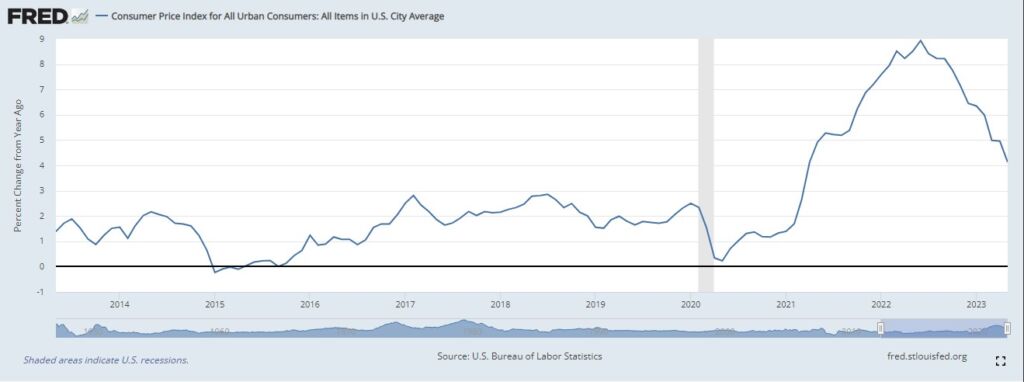Explaining inflation: The concept of ‘greedflation’ is ridiculous
A recent CNN article said:
After two years of surging prices, economists still can’t agree on what has caused the world’s worst inflation crisis in decades.
While the usual culprits cited by economists include pandemic-era supply chain bottlenecks, the war in Ukraine and various US economic policies, others say it’s due to “greedflation,” the idea that companies use higher inflation rates as an excuse to jack up prices and grow their margins.
The article, helpfully, has listed these explanations in order of plausibility. I’ll tackle them in reverse order over a couple of weeks.
Crude “greedflation”
This is, perhaps, the most useless explanation of all.
Remember what it is we are trying to explain: the rise in the rate of increase in the Consumer Price Index (CPI) – the inflation rate you hear about in the news – from 2.5% year on year in January 2020 to 8.9% in June 2022, seen in Figure 1. If corporate greed explains this, we have to ask why businesses suddenly got so much more greedy over the course of 2021 and 2022 than they had been previously. We also, of course, have to explain the fall in the rate of inflation since then: have corporations become less greedy since last summer? If so, what explains this?
Figure 1

I’ve argued before that if you are trying to explain the change in a variable, it is generally good practice to identify a variable which has itself changed. I don’t see any reason to think that corporate greed’ moves up and down in the way it has to for greedflation to explain the movements we have seen in the rate of inflation. If you think it does, drop me a line explaining how.
Sophisticated “greedflation”
CNN offers a slightly sophisticated version of the greedflation theory, namely “that companies use higher inflation rates as an excuse to jack up prices and grow their margins.”
This, obviously, is circular reasoning. It says that inflation offered greedy corporations an opportunity to raise their prices and that caused inflation, but it fails utterly to explain what caused the initial inflation. It is an explanation that fails to explain anything.
Over the last week, ‘greedflationists’ have received some succor from the International Monetary Fund (IMF), which tweeted:
Here, the IMF seems to be arguing that price increases in the pursuit of higher profits lead to inflation.
In fact, the paper mentioned in the tweet does not make that argument. It says:
Rising corporate profits account for almost half the increase in Europe’s inflation over the past two years as companies increased prices by more than spiking costs of imported energy. [Emphasis added]
Rising profits are not the cause of inflation but a consequence of it. As new money entered the economy as a result of Federal Reserve money printing, nominal demand surged and businesses raised prices to match it with supply. As I wrote recently about Minnesota’s businesses:
In 2021 and 2022, all that new money began bidding up consumer prices and profits surged: of the top ten companies in 2023, eight saw double-digit increases in their profits in 2022, ranging from 10.0% for 3M to 79.9% for Ameriprise Financial. But these companies have now bid up the prices of their inputs and this has squeezed profits even as revenues have generally continued to rise. This is what explains the fall in profits, not any decline in corporate greed over the last year.
Indeed, the IMF notes the same process at work in Europe:
Now that workers are pushing for pay rises to recoup lost purchasing power, companies may have to accept a smaller profit share if inflation is to remain on track to reach the European Central Bank’s 2-percent target in 2025, as projected in our most recent World Economic Outlook.
If anything, this episode is an example of why not to put a teenage intern in charge of your social media accounts.
Why “greedflation”?
Given that greedflation is such a useless explanation of inflation, it is worth asking why so many people believe it.
On reason is that it is politically convenient. If you spend your life looking for excuses to raise taxes on businesses, blaming them for inflation and proposing higher taxes as the remedy suits you down to the ground.
But greedflation also has the virtue of being a simple explanation. All it requires you to ‘understand’ is that business owners are both greedy and powerful. Grasping greedflation requires no engagement at all with more complex concepts like government financing, bond yields, the money supply – narrow or broad – the banking system, consumers demand to hold cash, or lags in monetary policy which are necessary to actually understand inflation. None of these ideas are beyond any reasonably intelligent person’s understanding, but it requires more thought than just ‘businesses are greedy.’
All too often, people favor an explanation which is wrong but simple over one that is right but complex. So it is with greedflation.